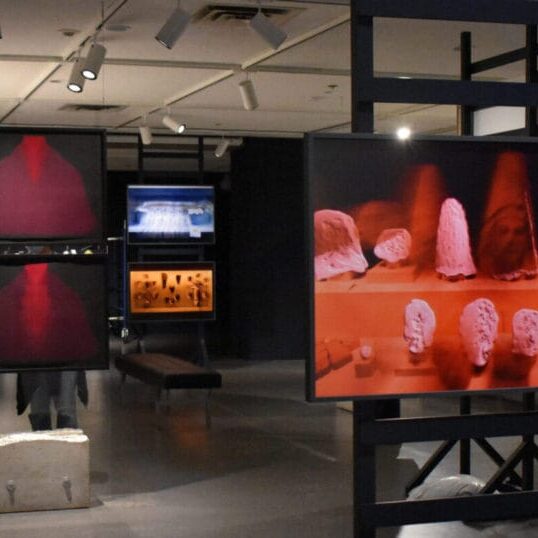
Exhibition invites museum-goers to deliberate on space, belonging and exploitation
Artist considers the ethics of museums’ role in collection and presentation
The concrete walls of the Dalhousie Art Gallery have been painted dark blue for Sameer Farooq’s exhibition The Fairest Order in the World.
The vibrant colour in Farooq’s pieces stands out vividly against the dark walls. The different shades of red in different pieces call out from within the exhibition like lighthouses, guiding the visitors throughout the gallery space.
The combination of the different elements of the exhibition, visual and auditory, is “intended to create an immersive space,” said curator Mona Filip, inviting onlookers “into a deeply poetic space to reflect on the fraught and violent histories of art and anthropology museums—their colonial origins, structures and impulses.”
Farooq’s The Fairest Order in the World opened on Oct. 5 in collaboration with the Prismatic Arts Festival. The exhibit is the first showing in his home province for the Cape Breton-born artist.
“The big question was, if museums were completely emptied of everything that they’ve stolen, how could we reuse these spaces? Farooq asked. “How could we think about collecting, how could we think about filling them up again?”
The exhibition showcases photographs and sculptures where objects are migrating out of the displays, leaving blank spaces behind. “It’s a lot of what’s absent and it’s a lot about grieving,” said Farooq.
Composed of pieces from two series, Restitution (2020-2021) and Gandhara (2023), the exhibition is “interested in ideas of repatriation of objects held in museums and trying to imagine what the return looks like,” said Farooq.
Farooq’s various pieces are choreographed throughout the space to create compositions like those in museums. However, they still undermine the way museums become glorified “holding devices for colonial spoils,” wrote Filip in her curatorial essay for the exhibition.
“As custodians of colonial spoils, museums weaponized time, manipulating geographic distance,” Filip wrote, saying they turned cultures overseas into a thing of the past, so stealing from them by force and domination didn’t feel criminal.
The audio environment for the exhibition was created by collaborator Gabie Strong. The sound is meant to set “a deliberate and slow pace,” wrote Filip. Each interval is marked by a bell and the sound piece is designed to guide the visitor to spend six minutes at each piece.
The exhibition also imagines ways museums could collect cultural artifacts more ethically.
Farooq suggests a process of discovery that is turned inward, rooted in encountering and understanding.
This process is “not based in this kind of extractive mode, but rather an inner excavation,” said Filip in an interview.
“What I’ve proposed is really developing like a series of ways to collect from our own experiences. Instead of collecting with the eyes open, I propose collecting with the eyes closed,” said Farooq. “I’m proposing almost a sort of spiritual process to deal with the harm that a lot of traditional museums have caused by displacing these artifacts.”
While it may seem like Farooq is a harsh critic of museums, he thinks they still hold value for culture within society.
“Museums can help make connections and tell stories that we wouldn’t be able to experience just being in one place. They kind of bring a lot of regions together.”
The pieces in the exhibition range from large images in display cases to plaster and ceramic sculptures of various shapes and colours, including onions. Farooq’s favourite piece is a display of 700 ceramic cast onions on a metal and brick stand.
“It’s supposed to be like an ode to an object that never appears in a museum, but it’s still very important to our everyday life,” he said.
The show will remain in the Dalhousie Art Gallery until Dec. 22. Admission is free.






